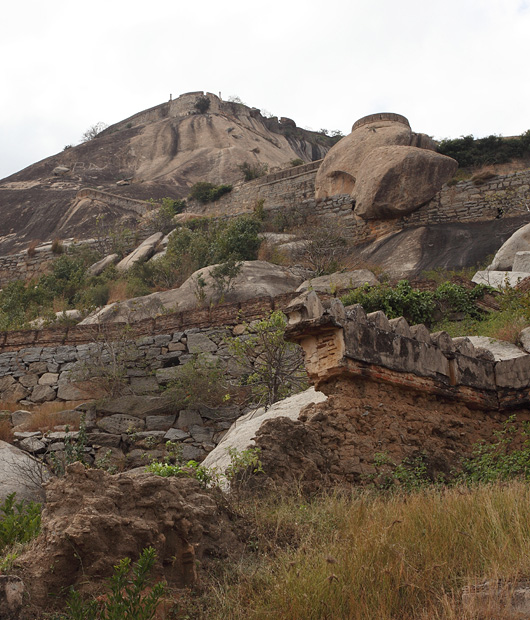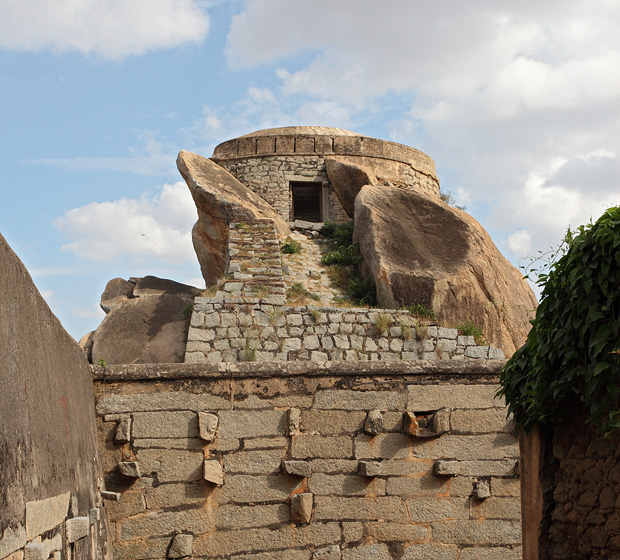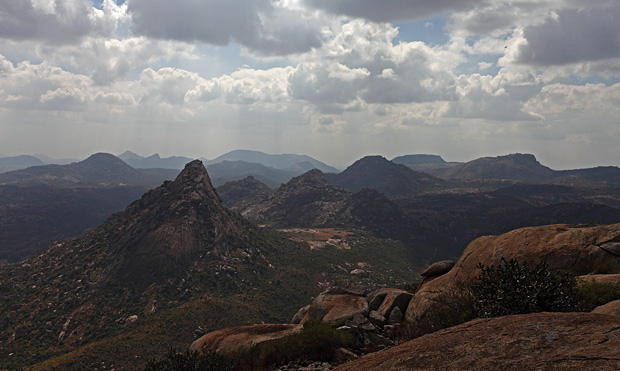Madhugiri Fort near Bangalore
This post turned out way longer than I expected!
Sometimes your impulse leads you to interesting things. Driving past Devarayanadurga about ten days ago, we saw a sign that read ‘Madhugiri’ and raced in that direction. In the next four hours, we went through some indecisive moments about climbing up steep slippery slopes, encountered surprises mid-way up the hill and eyed on beautiful landscapes from the top.
Looking up from the base of the hill, Madhugiri Fort looks like a maze of randomly built series of strong walls on the slopes. “30 to 45 minutes to go up,” we told ourselves as we looked at the last fort wall high on the peak. Adding another 20 minutes to get back and another 10 to gallivant on the top, we expected to be back in less than an hour and a quarter. It was 12.30pm, which means we could be back before 2pm and then look for a place in town to have lunch.

A section of Madhugiri Fort
We climbed slow and easy, pausing at a bastion that offered vista of the town, observing a waterway that filled up a tank in the fort and trying to make sense of some constructions that looked like store houses and dwelling for the soldiers. We went up through grassy slopes in the first five minutes and soon found us going up on steep rocky surface with nothing more than small etchings that served as supporting footsteps. The climb wasn’t exactly a skilled and adventurous activity, but we were occasionally forced to crawl up through slippery sections. My hesitant partners decided to stop just before the last visible wall, their unwillingness to go further amplified by a returning visitor who said ‘there is nothing up there.’

A fort bastion
I can never trust people who tend to see ‘nothing’. I have seen people traveling through some of the finest landscapes in the Indian plains and exclaiming that ‘there is nothing out there’. On a safari jeep deep in the heart of Corbett National Park where River Ramaganga meandered through thick sal forests, grasslands and beautiful foothills, I was appalled by a group of people who remarked with dissatisfaction that ‘all that this place has is forest, forest and more forest’. I have heard people being bored driving through mountains seeing ‘nothing’ but seeing ‘just mountains’. I have seen people unmoved by remarkable shows of nature and merely reducing it to ‘nothing’.
People tend to become blind to their surrounding when they do not see what they are anticipating. Perhaps this person was looking for a temple, an ordered construction, a spring, or if he is out of his mind – a shopping mall complete with glistening glass walls and the flashiest brands. As I was climbing up the slope, I was already becoming aware of the landscape around the fort, with hills dotting the surroundings and wide sprawl of lakes between them. Assisted by patches of clouds that blocked the sun, light and shadow alternated on the peaks, selectively highlighting some and subduing their neighbours.
I continued further up, past a steep section that required some careful climbing, arriving at the highest wall we saw so far. I anticipated a small plateau that would open up to the vistas of a range of hills on the other side, villages and lakes equally beautiful or perhaps even better. While our first surprise came in the form of the steep slopes that we encountered on the way up, the second one was something I was completely unprepared for. As I walked through the gates of the high wall, I saw the earlier invisible slopes that teased me and invited me to climb further. My already tired body looked up and groaned as I realized we had not even come half-way and were deceived by the walls that blocked our view to the highest point.
There I was, standing mid-way up the Madhugiri Fort, past lunchtime without a drop of water or an ounce of food, left to decide weather to go up or come down. It was a hot summer morning and there was every temptation to head down, but I was even more tempted by short glimpses of the tall hills that spread across the other side of the fort. My fellow travellers had already decided to head back and were waiting for me to return.
Lure of the mountains is always strong, however small the mountains are. It took me less than a minute to decide to continue up and another minute to motivate others. We were striding up soon, going up slopes that only seemed to get steeper and more troublesome. The fort is built in such a location that it would perhaps take even the strongest enemy all his energy and determination to push his way up the hill.

View from Madhugiri Fort
It must have taken us more than 2 hours to reach the top and go through the last of the fort wall—this time last one for real. Located on the top are shelter built of stone that could house a few hundred people, perhaps meant to house the soldiers who guarded the fort. Standing on the top of one of those shelters, I was blessed with the views that made up for the effort of the climb. A series of hills marked the western landscape, dominated by a narrow and rocky peak projecting nearly as high as my platform. A thin road bisected through the hills leading somewhere into their heart and beyond. The afternoon haze limited my views but the contour of the distant hills looked beautiful enough that I made a note to come back here again for an early morning visit.
Hunger and thirst drove us back and we descended down quickly in next 45 minutes, making our way for the nearest tender coconut vendor. It was about 4.30pm when we finally ordered our lunch that afternoon.
With the newly acquired respect for the fort, I came back home and looked up on the facts and history on Madhugiri (sources: wiki, business line, mouth shut). The hill is at an elevation of 3930 feet and is the second largest monolith in Asia. The first work on the fort dates back to Ganga Kings, while the walls remaining today are credited to a local chieftain named Heere Gowda, a feudal of the Vijayanagar Empire. Since the collapse of the empire, the fort was administered by Hyder Ali, Tipu Sultan and later by the Mysore Wodeyars. The fort is currently managed by Archaeological Survey of India.
Information.
Madhugiri Fort is approximately 110km from Bangalore. You can drive out to Tumkur on NH4, turn right and drive for another 40+ kilometers to reach Madhugiri (see map). Alternatively you can turn right at Dobbspet, about 20km after the toll gate at Nelamangala and take the road to Madhugiri. See the map below for precise driving directions.
It takes up to 2 hours to get to the top and an hour to get back. Sections of the climb are steep and can be difficult. Carry food and water, as there is nothing available on the way.
Below is the map of driving directions from Bangalore to Madhugiri.
View Bangalore to Madhugiri in a larger map
